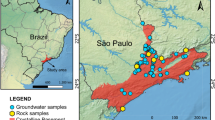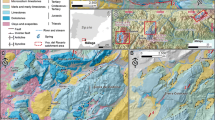Abstract
Karst formations are often responsible for the decay of building foundations and road infrastructure. Three conditions are required for the development of karst: porous or fractured rock subject to water filtration, water dissolving rock, and conditions for water exchange (saturated ions prompting water outflow and inflow of new aggressive water for soluble rock). Individual estimation of rock masses which dissolve in an aeration zone and in an unconfined aquifer is an advanced feature for developing karst protection. This article describes modified algorithms of thermodynamic and kinetic calculations for the interactions of groundwater and carbonate rock based on investigations conducted on the karst terrain of the Izhora Plateau, located in the northwest of the Russian Federation. The upper part of the Izhora Plateau consists of Ordovician carbonate rocks (limestone), in which karst has developed. Karst sinkholes emerge on the Izhora Plateau in quantities of 100–300 each year. Groundwater and infiltration waters were sampled to determine chemical composition in different locations of the Izhora Plateau. An estimation of the groundwater reserves for the territory of the Izhora Plateau (2200 km2; size from North to South is 55 km; East to West 40 km) has never been carried out employing carbonate rock interactions through thermodynamic and kinetic methods. Chemical composition of groundwater and infiltration water is a base for thermodynamic calculations and kinetic calculations of interactions between groundwater and infiltration water with rocks and CO2. The result of complex heterogeneous investigations determined that 53% or 1.42 × 108 kg year−1 of carbonate rock in the tested area dissolved in the aeration zone. In the aquifer, the upper part formed an unsaturated layer, which dissolves carbonate rocks. This layer dissolves 47% or 1.24 × 108 kg year−1 of rock. In this work, we also present original methods for arriving at these calculations. These investigations can help in organizing efforts to reduce the quantity of new karst sinkholes.









Similar content being viewed by others
References
Arvidson RS, Evren EI, Amonette JE, Luttge A (2003) Variation in calcite dissolution rates: a fundamental problem? Geochim et Cosmochim Acta 67(9):1623–1634
Bonacci O (1987) Karst hydrology with special reference to the Dinaric karst. Springer, Berlin, Heidelberg, p 184
Brantley S, Kubicki J, White A (2008) Kinetics of water–rock interaction. Springer, New York, p 842
Craig BM, Sharon Y (2008) Guide of the program: "The Geochemist’s Workbench Essentials", University of Illinois, USA, January 3, 2017, p 180
Drever JI (1988) The geochemistry of natural waters. Pearson Education Canada, p 437
Dreybrodt W (1988) Processes in karst systems: physics, chemistry, and geology. Springer, Berlin, Heidelberg, p 288
Dreybrodt W, Eisenlohr L (2000) Limestone dissolution rates in karst environments. Speleogenesis: evolution of karst aquifers, pp 136–148
Dreybrodt W, Gabrovsek F (2002) Basic processes and mechanisms governing the evolution of karst. Evolution of karst: from prekarst to cessation. Carsologica. Zalozba ZRC, pp 115–152
Ford D, Williams P (2007) Karst hydrogeology and geomorphology. Wiley, USA, p 578
Garrels RM, Christ CL (1965) Solutions, minerals and equilibria. Happer & Row, New York
Goldscheider N, Drew D (2007) Methods in karst hydrogeology. Taylor & Francis Group, London, p 264
Grejser EL (1992) Groundwater research for water supply of the Lomonosov. Kronshtadt and Peterhof, Saint-Petersburg, p 290
Gvozdeckij NA (1981) Karst: monograph, Moscow, p 218
Konosavsky PK (2011) Specifics of numerical modelling use for estimation groundwater resources for water supply Kingisepp town. VSEGINGEO, Moscow
Lehov AV (2010) Physics and chemical hydrogeodynamics. KDU, Moscow, p 500
Morse J, Arvidson R (2002) The dissolution kinetics of major sedimentary carbonate minerals. Earth Sci Rev 58:51–84
Morse JW, Berner R (1972) Dissolution kinetics of calcium carbonate in sea water: II. A kinetic origin for the lysocline. Am J Sci 272:840–851
Morse JW, Mackenzie FT (1990) Geochemistry of sedimentary carbonates. Elsevier, USA, p 725
Morse JW, Arvidson RS, Luttge A (2007) Calcium carbonate formation and dissolution. Chem Rev 107:342–381
Nikolaev AS, Timonin AA (1986) Research exogenous geological processes in 1983–1985. North-West hydrogeology and engineering—geology group. Leningrad
Plummer LN, Wigley TML, Parkhust DL (1978) The kinetics of calcite dissolution in CO2—water system at 5° to 60 °C and 0.0 to 1.0 atm CO2. Am J Sci 278:179–216
Pokrovsky OS, Golubev SV, Scott J, Castillo A (2009) Calcite, dolomite and magnesite dissolution in aqueous at acid to circumneutral pH, 25 to 150 & #xB0;C and 1 to 55 atm pCO2: new constraints on CO2 sequestration in sedimentary basins. Chem Geol 265:20–32
Qingjie G, Jun D, Qingfei W, Liqiang Y, Min S (2010) Experimental determination of calcite dissolution rates and equilibrium concentrations in deionized water approaching calcite equilibrium. J Earth Sci 21(4):402–411
Rumynin VG, Harhordin IL, Potapov AA (2003) Assessment of industrial influence on groundwater and adjacent nature objects in Leningrad region. Saint-Petersburg State University, Saint-Petersburg, p 208
Sjoberg EL (1978) Kinetics and mechanism of calcite dissolution in aqueous solutions at low temperatures. Acta Universitatis Stockholmiensis XXXII:1
Zhdanov S, Kurilenko V (2013) Problems of water management in Izhora ground water deposit. Proc Min Univ 200:216–221
Author information
Authors and Affiliations
Corresponding author
Rights and permissions
About this article
Cite this article
Zhdanov, S.V., Kurilenko, V.V. Quantitative groundwater estimation of Izhora Plateau, Russian Federation using thermodynamic and kinetic methods for carbonate rock interaction in identified karst terrain. Carbonates Evaporites 32, 403–414 (2017). https://doi.org/10.1007/s13146-017-0351-8
Accepted:
Published:
Issue Date:
DOI: https://doi.org/10.1007/s13146-017-0351-8




